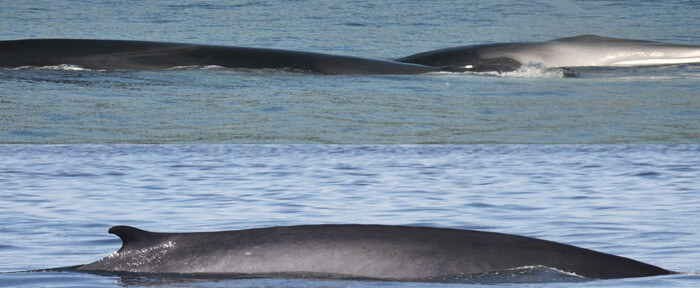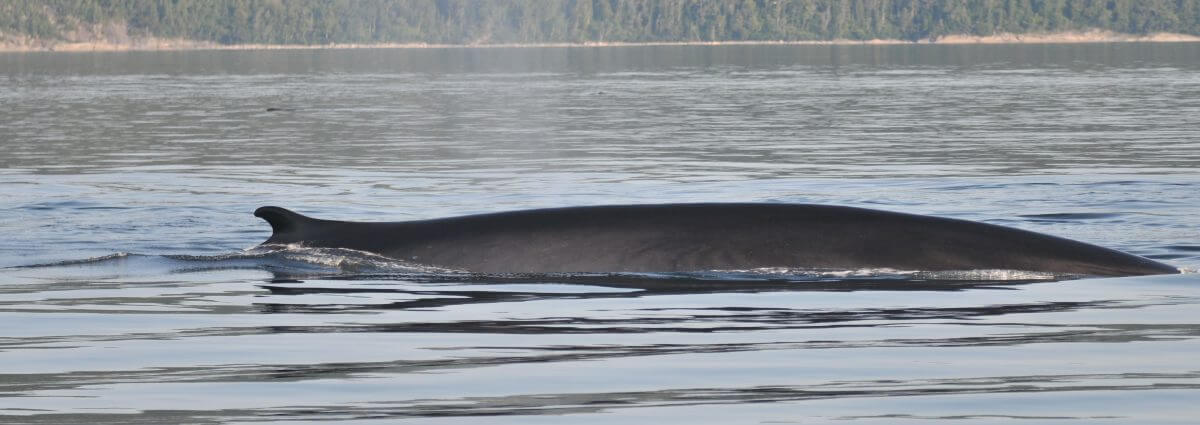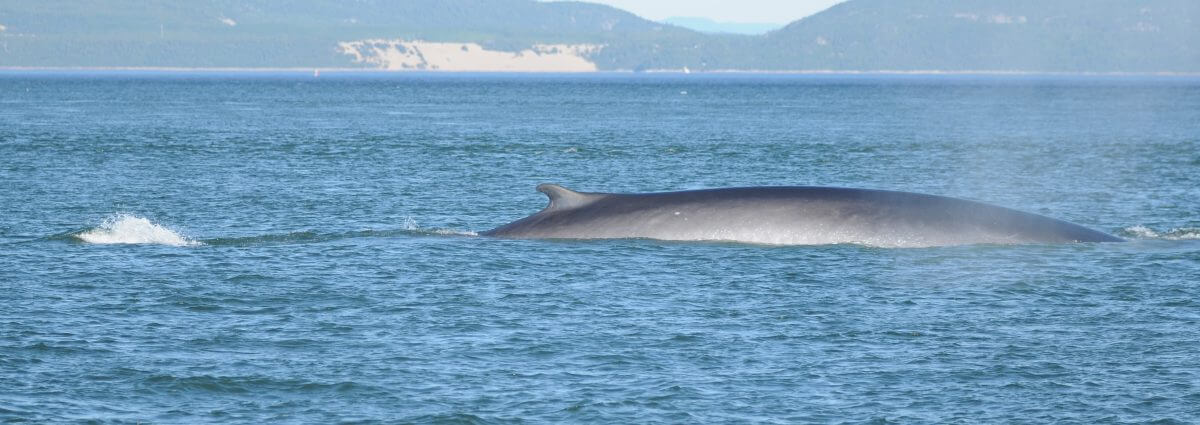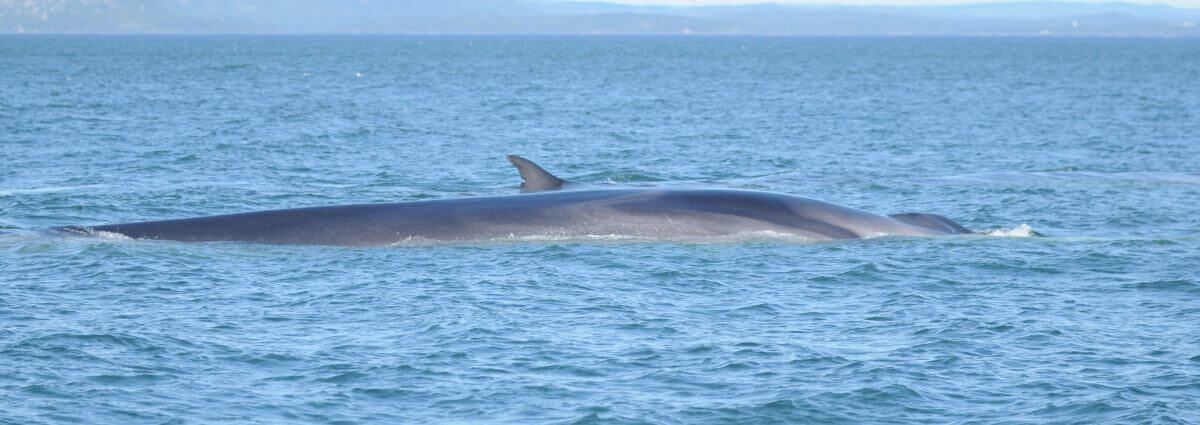Bp030
Fin Whale


-
ID number
Bp030
-
Sex
Unknown (possibly female)
-
Year of birth
Unknown
-
Known Since
1991
Distinctive traits
It is not easy to identify Bp030, as its distinctive markings are subtle. The particular curvature of its dorsal fin, the notch and slight bulge located respectively at the tip and base of the fin are a few examples.
Its right chevron has sharp contours, and a thin scar marks the right side of its peduncle.
For a long time, it was believed that Bp030 was also the individual Bp066, having observed its right side (Bp030) and its left side (Bp066) in turn.
In 2008, a new mark visible on both sides appeared, confirming that it is indeed a single animal.
Life history
Bp030 is a regular visitor to the estuary, and the GREMM team has photographed it regularly since its first sighting.
In July 2012, the animal surprised researchers by appearing off Les Bergeronnes with a young calf at its side. In the days that followed, it was seen again by the GREMM team and by tour boat captains, still accompanied by the young animal. Although its sex has not yet been confirmed by genetic analysis, it had never been observed with a calf before.
Bp030 is particularly large! Among fin whales, blue whales, and humpback whales, there is sexual dimorphism, i.e., a marked difference in size between males and females. Females are generally larger, which explains the assumption about its sex. In fact, females of this species are 5 to 10% larger than males. The evolutionary origin of sexual dimorphism within a species can be explained by differences in parental investment.
Observers found it emaciated that summer, as evidenced by the pronounced outline of its spine. It is indeed possible that this emaciation is attributable to the extraordinary investment that breastfeeding represents for a whale. Intense and efficient, breastfeeding provides milk rich in fat that the female draws from her subcutaneous reserves.
Observations history in the Estuary
Years in which the animal was not observed Years in which the animal was observed
Latest news from the publications Portrait de baleines
This fin whale is a regular in the Estuary, having been photographed 17 years out of 22 since it was first observed. Nevertheless, it is not a very well known “face” due to the subtleness of its distinctive marks: a particular curve at the top of the dorsal fin, slight notch at the top and bulge at the base of the said fin, right chevron with sharp contours and a thin scar on the right side of the peduncle. A well-trained eye and good photos are essential!
Bp030 surprised GREMM researchers on July 29 when it showed up off the coast of Les Bergeronnes with a young calf at its sides. In the days that followed, Bp030 was sighted again by the GREMM and whale-watching boats, always accompanied by the young. Was Bp030… a mother? Its sex has not yet been confirmed by genetic analysis and it had never previously been observed with a calf. On the other hand, it is a large fin whale, and in this species, females are 5 to 10% larger than males.
Another clue that it is possibly a mother: Bp030 is visibly thinner this year, as revealed by the marked contour of her vertebral column; this is perhaps the result of the extraordinary investment that nursing represents for a whale. Intense and efficient, nursing provides milk that is high in fats, which the female draws from her subcutaneous reserves. As births usually take place in winter and nursing lasts 6 to 8 months, Bp030 should be about to wean this calf, who will then be independent.
Fin whales have a life expectancy 80-90 years. The young animal seen accompanying Bp030 might be plying the waters of the St. Lawrence for many moons to come! Will we recognize it? Tough to say, as it seems that young fin whales change a great deal as they reach adulthood. To be continued!
The September 17, 2008 issue of Portrait of Whales confirmed that fin whale Bp030 was in fact the right side of Bp066, an animal whose left side had been photographed previously. In fact, during the summer of 2008, the GREMM team had made a match. It took a new mark visible on both sides of the animal and the certainty in the field that we were dealing with a single individual to make the connection between the two sides of this animal.
Bp030 can be recognized by the distinctive curve at the top of its dorsal fin, the bulge in front of it, and its sharply defined chevron pattern. It was spotted and photographed last week near buoy K55 at the head of the Laurentian Channel, opposite the Tadoussac sand dunes. First alone, then among a group of other fin whales, including Capitaine Crochet.
It seems that such gatherings of fin whales in this confluence zone of the Saguenay and St. Lawrence rivers are no coincidence. The very different currents of these two waterways form fronts and thermal barriers that cause food to accumulate, especially around high tide. In addition, when fin whales feed on capelin rather than krill, they tend to hunt in groups for this prey, which is more mobile than krill and therefore more difficult to hunt. Could this be a form of collaboration or competition between fin whales?
Bp030 is particularly large! Among whales, there is sexual dimorphism, with females being larger than males, probably because they have to invest much more energy than males in caring for their young. In other species, male/female differences can be explained by “sexual selection” (a marked preference for certain characteristics in the opposite sex) or by competition between males.




